US Needs LNG to Fight a Two-Front Gas War

Table of Contents
Author(s)
Steven R. Miles
Nonresident Fellow at the Baker Institute Center for Energy StudiesGabriel Collins
Baker Botts Fellow in Energy and Environmental Regulatory AffairsAnna B. Mikulska
Former FellowShare this Publication
- Print This Publication
- Cite This Publication Copy Citation
Steven R. Miles, Gabriel Collins, and Anna Mikulska, "US Needs LNG to Fight a Two-Front Gas War" (Houston: Rice University’s Baker Institute for Public Policy, August 18, 2022), https://doi.org/10.25613/GDVP-QN45.
Executive Summary
As Russian forces invaded Ukraine in the early winter of 2022, it seemed Europe’s dependence on natural gas from Russia might leave European nations with a stark choice: capitulate and accept Russia’s aggression, or suffer a potentially catastrophic energy shortage with dire economic, political, and social consequences. Fortunately, concerted action by the United States and its allies produced a liquified natural gas (LNG) ‘GasLift’ that flooded European terminals and succeeded in pulling Europe through the winter of 2022. But launching a winter 2023 GasLift to supply sufficient energy to Europe could prove considerably more challenging given further Russian gas reductions, unexpected LNG facility outages, and possible domestic export restrictions in some countries.
The gathering storm in Asia further heightens Europe’s gas insecurity. Russia took advantage of extremely tight markets and uncertainty by nationalizing the Sakhalin II LNG plant just days after outages at major LNG plants in the US and Australia, challenging the gas security of US allies in Asia, particularly Japan and South Korea. Compounding matters, China’s “live-fire” military exercises in the Taiwan Strait effectively blockaded Taiwan’s two LNG import terminals, signaling future energy insecurity for the island.
With conflict on two fronts, and natural gas squarely in the crosshairs, the US LNG industry will need to maintain commitments and support allies and trading partners in both Europe and Asia this winter. Unity and resolve among allies and partners, as well as tolerance for some domestic sacrifices, will be necessary to ensure a level of energy security on both fronts. Weather, war, and the whims of black swan risk factors could coincide to yield the most challenging winter for energy markets seen in decades. Maximizing molecule flows into the global gas market is a distinct US national security interest.
The Europe GasLift of 2022
No US soldiers are fighting in Ukraine, but in most other respects the United States is effectively in a war posture. Consider the following five metrics:
- In response to Russian threats and actions, NATO allies recently agreed that Russia “is the most significant and direct threat to their security and to peace and stability in the Euro-Atlantic area.”[1]
- The US has contributed nearly $9 billion of military aid to Ukraine[2] and $54 billion in total aid in response to the Russian invasion since February 2022.[3]
- US and allied troops, ships, and aircraft have been re-deployed to NATO’s eastern flank.[4]
- The US has imposed unprecedented economic sanctions on Russia.[5]
- The US is engaged in a massive diplomatic effort to rally nations worldwide to enforce these sanctions and to support its allies in Europe.
Shortly before the invasion of Ukraine, we published “Strategic Response Options if Russia Cuts Gas Supplies to Europe” urging the US and its allies to launch a Berlin Airlift-style GasLift of LNG to relieve Europe of the stranglehold that Russia’s growing cutoff of natural gas was causing.[6] We presented evidence to show that world LNG supplies, when coordinated by nations and used in conjunction with other steps, could be sufficient to resupply Europe through the winter of 2022 and refill storage over the summer.
In the months that followed the invasion, a flood of LNG cargoes, largely from the US but also from other nations, pushed northern European LNG receiving terminals to run at or above nameplate capacity, as we noted in “US LNG ‘GasLift’ Floods European Terminals Ahead of Russia Gas Cutoff.”[7] In a follow-up brief, “A Bridge Over Troubled Water: LNG FSRUs Can Enhance European Energy Security,”[8] we urged European nations and gas buyers to charter and site LNG floating storage and regasification units (FSRUs) before the coming winter in order to open the bottleneck presented by limited European LNG receiving capability. Since then, several gas buyers have announced such charters of FSRUs for European sites, some of which will be operational in a few months.[9]
In order to provide the LNG needed by Europe, US LNG producers operated their plants at or above 100% of baseload capacity. This was required because Russia began reducing its deliveries of natural gas to Europe almost a year before its invasion of Ukraine, which tightened the European market, created a surge in prices, and drove increased competition for available LNG supplies. As Figure 1 illustrates, from March 2021 until June 2022, daily US LNG export capacity consistently operated between 80% and 100% of peak utilization, which effectively means operating at or above 100% of baseload capacity for the US LNG industry overall.[10] Running at such high utilization rates for so long can put a strain on the entire LNG export value chain.
Figure 1 — Daily US Liquefied Natural Gas Export Capacity (Peak) Utilization (Jan 2017–Jun 2022)
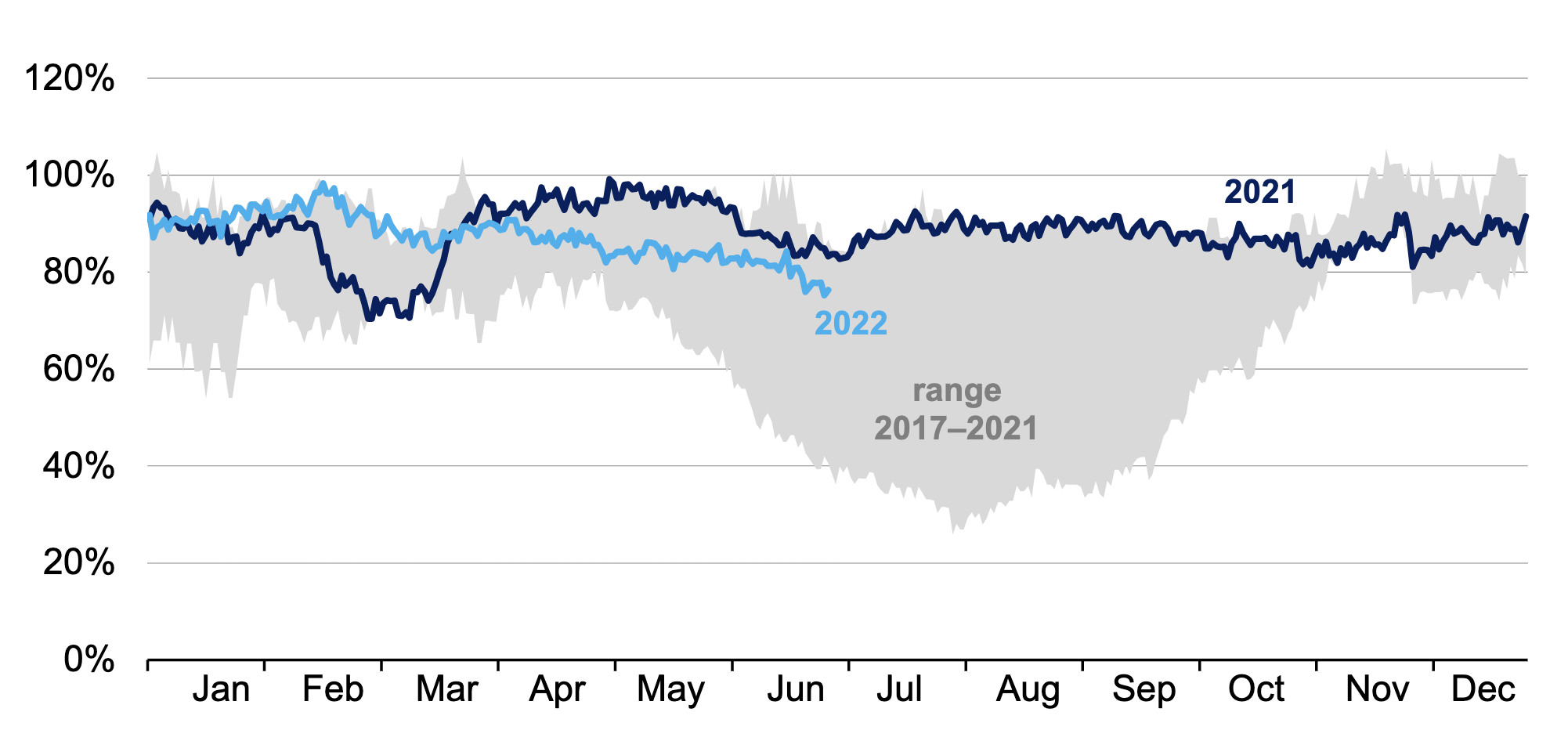
Can the GasLift be Repeated for the Winter of 2023?
We are yet to emerge from this year’s summer, and already several events have made the GasLift more tenuous for the coming winter. The June 8 outage of the Freeport LNG facility, which provided some 72% of its 15.0 million tonnes per annum (mtpa) baseload capacity to Europe during the first five months of 2022,[12] was a significant event that tightened available supply. The impact was immediately felt as US LNG deliveries to northern Europe (including the Netherlands, France, Belgium, Poland, and Lithuania) declined by 35% in June and July compared to May,[13] despite extremely hot weather and heavy electricity demand in Europe.[14]
Just 10 days after the fire at the Freeport LNG plant, Gazprom reduced gas deliveries to Europe on the Nord Stream 1 (NS-1) pipeline to less than half the average flow rate of the 365 days preceding, according to ENTSOG data. These deliveries were further curtailed on July 27 to 20% of NS-1’s capacity.[15]
Tightened supplies and higher prices make it more difficult for Europeans to fill their storage ahead of the coming winter. The EU has set up an 80% target for country-level storage by November 1, 2022 (90% in years thereafter) (EU 2022/0090).[16] Germany also now requires storage to be 95% full by November 1,[17] a level that it anticipates needing to sustain itself without gas imports for approximately two winter months.[18]
The situation of little or no Russian gas supplies over the winter is well within the realm of possibility given Germany’s heavy dependence on Russian gas supplied via the NS-1 pipeline. Since the NS-1 curtailment, European gas consumers have continued filling storage at rates commensurate with the trailing five-years’ average (Figure 1). At 20% flows on NS-1, Germany will have to strain to meet the 95% regulation-mandated levels even with current measures that redirect gas flows from industry and electricity generation to storage.[19] Although they are moving ahead quickly,[20] this comes at the cost of serious industrial demand destruction.[21] Data from transport system operators across Western Europe suggest that in many areas, industrial gas demand between April 1 and July 22, 2022, declined between 10% and 25% relative to the same period in 2021—when high prices were already materially eroding industrial gas consumption throughout Europe.[22] De-prioritizing industrial demand to protect residential consumers is not a sustainable long-term strategy.
Figure 2 — Estimated Gas Storage Inventory Levels, October 1, 2022
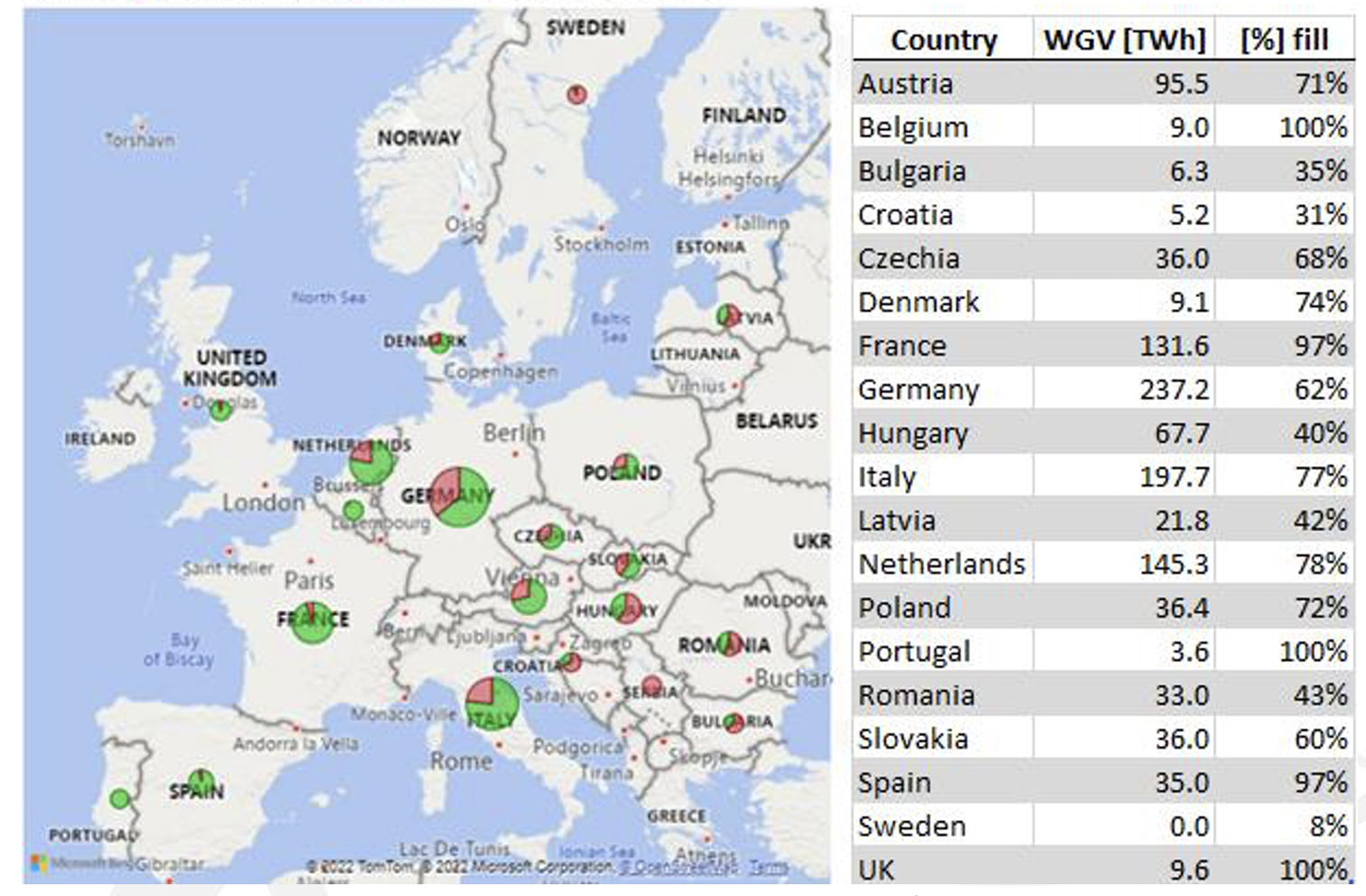
Having already significantly reduced supplies of natural gas to industry and electric power generation over the summer, Europe cannot demand-manage its way out of an upcoming winter gas crisis, particularly if storage is not filled in advance. More supply is needed and soon. The recent announcement that the US Pipeline Hazardous Materials Safety Administration (PHMSA) expects to authorize resumed operation of all three Freeport LNG trains at virtually full baseload capacity in early October 2022 will help blunt the ongoing supply shortfall, but it will come too late to provide much assistance in filling storage before winter.[24]
However, the larger challenge may be the gathering storm in Asia.
The Gathering Storm in Asia
When Russia invaded Ukraine in February and the US GasLift to Europe began in earnest, US diplomats sought support from other LNG suppliers, principally Qatar,[25] as well as from other LNG buyers who might be willing to divert some of their own cargoes to Europe. The argument was that by doing so, these LNG buyers—US allies in Asia, including Japan and South Korea—would be helping the US and Europe stand up against an aggressive sovereign power, and that one day they might need similar assistance. Japanese officials agreed that their companies would be willing to divert some LNG cargoes to Europe, so long as Japan retains a “stable” supply.[26]
In the last few months, however, several events have called into question whether Japan—as well as other US allies and friends in the region, including South Korea and Taiwan—have a “stable” supply of LNG that will be sufficient to meet even their own needs, let alone support Europe.
Liquefaction Plant Outages Tighten Markets
To begin, markets tightened in June because of the outage at the Freeport LNG terminal, where offtakers include companies from Japan and South Korea. Later that month, Shell’s 3.6 mtpa Prelude LNG plant in Australia shut down due to a labor dispute, shortly after recovering from a four-month mechanical repair. The facility, which has offtakers from Japan, Korea, and Taiwan, has been inoperative a total of six out of eight months this year, depriving these offtakers of vital supplies and the assurance of supplies for the coming winter.[27] In addition, Australian LNG supply to international markets has been called into question by the Australian government, which publicly raised the possibility of imposing a cap on LNG exports from the eastern part of Australia due to high domestic natural gas prices.[28] South Korea’s Kogas is one of the offtakers from the LNG projects that would be affected by a cap on Australia’s LNG exports.
Russia Takes Advantage of Uncertainty
As we noted in a working paper from August 4, 2022,[29] the increasing uncertainty over gas supply has been used tactically by Russia in Europe—and now is also being used in Asia. It is hardly a coincidence that on June 30, only days after Freeport’s outage and strikes immobilizing the Prelude, Russia announced the nationalization of the Sakhalin II LNG liquefaction plant.[30] The plant currently supplies LNG to several countries including Japan, for whom it supplies 10% of the country’s LNG needs, and South Korea, where about 6% of total LNG imports come from Russia.[31] At the same time, Russia has declared both countries “unfriendly states” due to their support of sanctions against Russia over its invasion of Ukraine.[32] Although Japan's Industry Minister Koichi Hagiuda said the decree did not mean that Japan's LNG imports will become “immediately impossible,” he also noted that it would be necessary for Japan “to take all possible measures” to prepare for a possible cutoff of LNG from Russia. Kremlin designations of Japan and South Korea as “unfriendly” fit a pattern of Russian behavior in which molecules and uncertainty surrounding their future availability are conjunctively weaponized to destabilize the economic and political environment in countries seen as allies of the US and NATO. [33]
Asia Allies May have to Compete with Europe for Extra Winter Cargoes, Hindering the GasLift
Rather than having “stable” LNG supplies as winter is approaching, Japan, Korea, and Taiwan are faced with extremely tight markets riddled by uncertainty related to three elements at once: 1) unexpected supply outages in otherwise reliable markets in the US and Australia; 2) Russian nationalization of the Sakhalin II LNG plant, creating uncertainty around its LNG supply this winter; and 3) domestic pressures in some traditional supplier countries for export bans or caps as a result of higher domestic prices for natural gas. The tightness of the markets is exacerbated by Asian buyers’ competition with Europe for additional LNG supplies, because of both the reduction in Russian gas supplies on NS-1 and Europe’s increased demand. That demand is driven by new LNG facilities being built onshore or chartered as floating storage and regasification units (FSRUs) and by Europe’s need to accelerate filling its gas storage for the coming winter.
It is hardly a surprise that at the recent Quad meeting of Australia, Japan, India, and the United States in Sydney, representatives of Japan and Germany separately met with officials from Australia to press them to make new LNG supply commitments, creating the unusual scenario of Europe and Asia competing for new supplies from a country that is considering reducing them.[34] With conditions of much higher-than-normal uncertainty, Japan, Korea, and Taiwan (as well as many others) must now go into the market to either backfill, or at least backstop, potential shortfalls from what it thought were certain long-term supplies.[35] These countries will likely find the cupboard bare if they are asked to contribute LNG cargoes to Europe this winter.
Instead, US producers may have to step in to ensure supplies to Asian allies and trading partners and fill any gaps, even as US producers are pushing utilization limits to supply a GasLift to Europe this winter. As Figures 3 and 4 from the US Energy Information Administration illustrate, however, to supply Europe in the run-up to and throughout the invasion, the US LNG industry and its customers have been “borrowing from Peter to pay Paul” by diverting cargoes from Asia to Europe.
Figure 3 — Monthly US Liquefied Natural Gas Exports by Destination Region (Jan 2020-Apr 2022), billion cubic feet per day
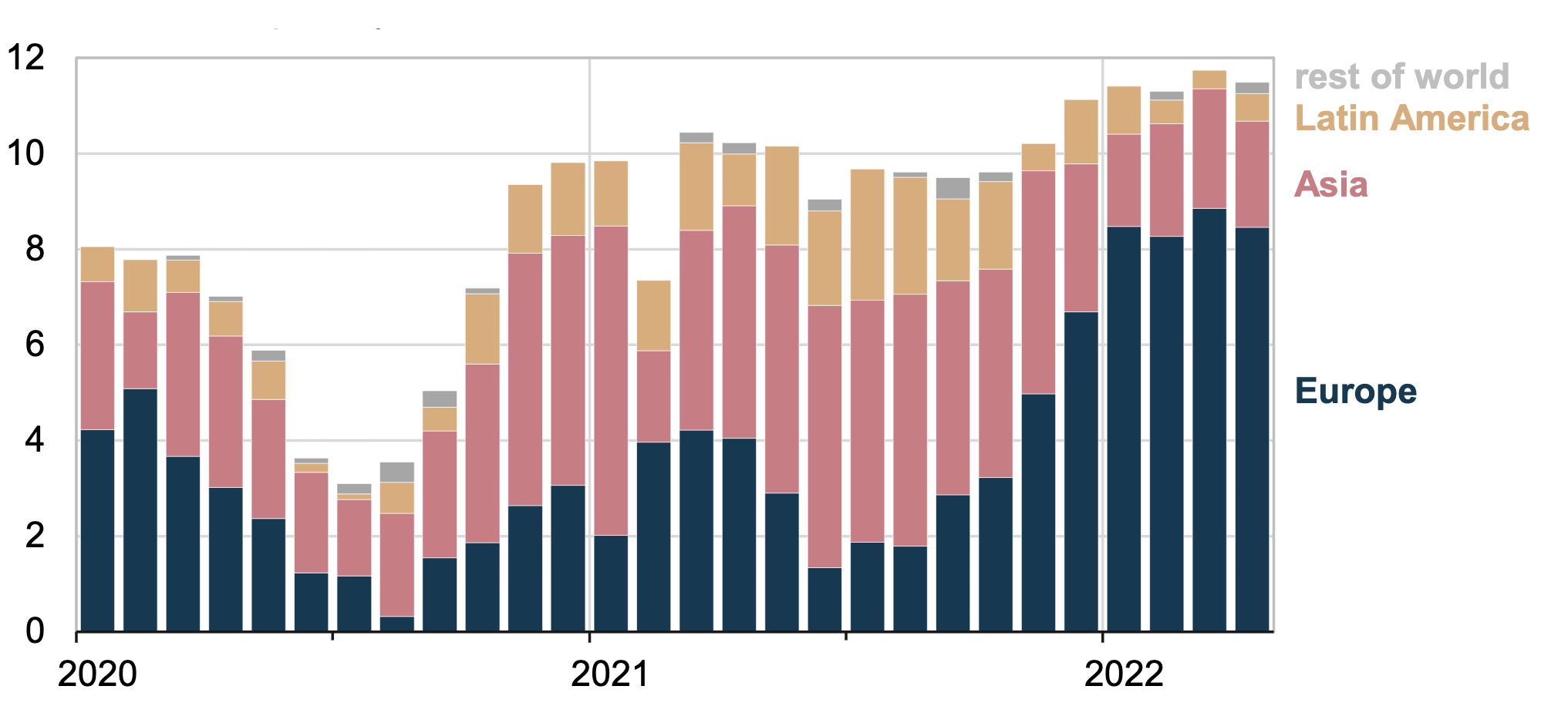
Figure 4 — Monthly US Liquefied Natural Gas Exports by Destination (Jan 2020-Apr 2022) billion cubic feet per day
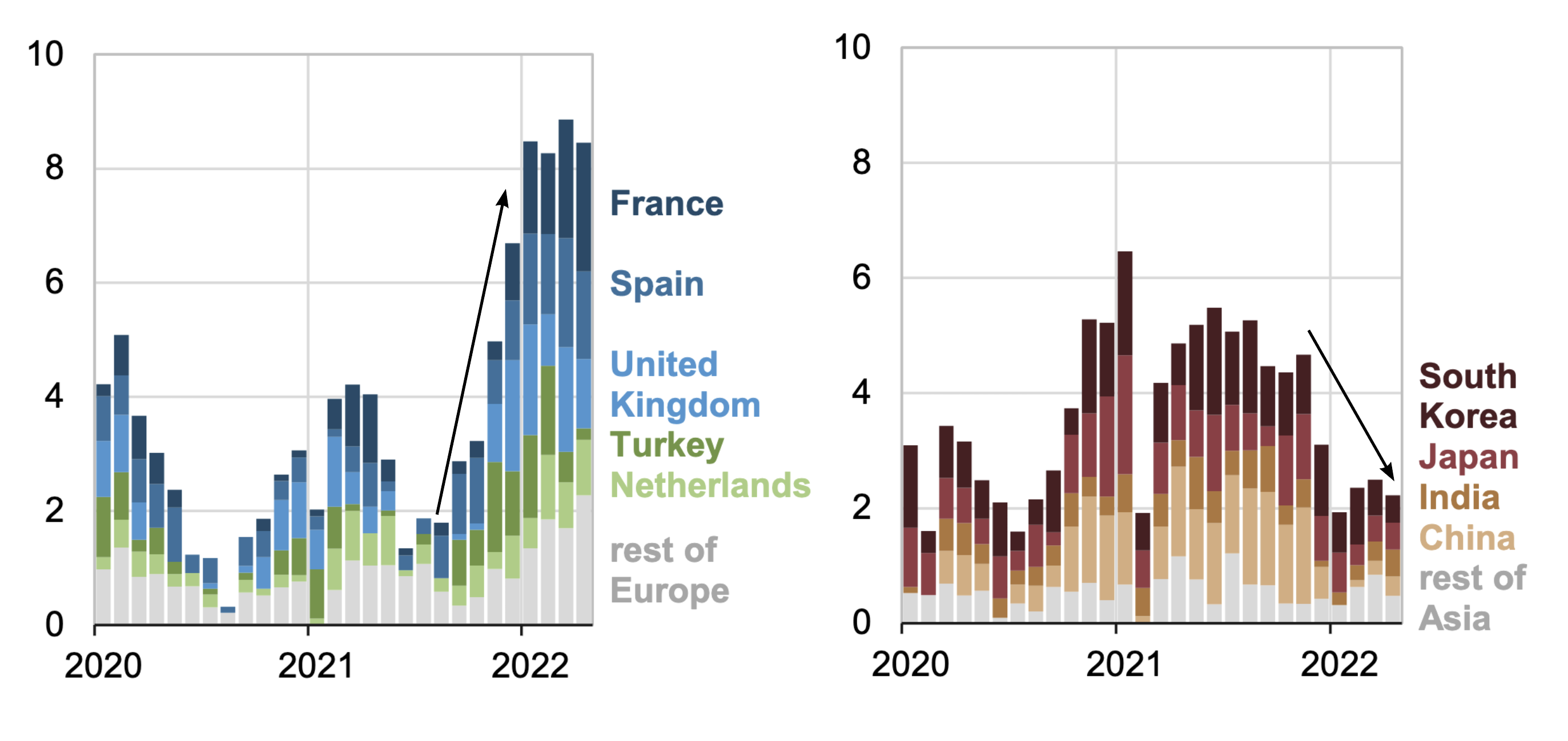
With the US LNG industry running above 100% of baseload and close to 100% of peak capacity during this past winter’s GasLift, there was not much if any extra capacity to call upon. If Europe and Asia are both in extremis this winter—whether because of unusually cold weather or due to conflict or other unforeseen events—then US suppliers and their customers will be forced to do their best to allocate available LNG cargoes across both the European and Asian fronts.
Some circumstances may make this even more challenging.
Enter China: Live Fire in the Taiwan Strait
For Taiwan in particular, recent events have elevated this risk to a new level. On August 4, 2022, the Chinese People’s Liberation Army began “live-fire” military exercises in six zones immediately surrounding Taiwan. China warned airlines to avoid the area,[38] but LNG tanker owners took immediate notice too. LNG tanker traffic immediately diverted away from the Taiwan Strait, though in practice the only destination (other than China itself) that was affected was Taiwan. Of 136 laden LNG tankers that crossed the Taiwan Strait from January 1 to August 3, 2022, 76 were headed to Taiwan.[39] Qatar Energy uses this shipping lane to deliver LNG cargoes to the Taichung terminal; Taiwan also receives LNG cargoes at the Yung-An terminal in Kaohsiung.[40]
The live-fire exercises are planned to end soon and hopefully will. But they plant the seed that Taiwan’s energy supplies are not secure. Taiwan claims that the exercises are effectively a blockade of its major ports, and a map of the live-fire zones supports that concern. The Yung-An facility is completely blanketed by China’s military exercises, while Taichung is limited by its access to the Taiwan Strait, which, as noted, becomes shut to LNG tanker traffic in a potential conflict.
Figure 5 — Map of Chinese People’s Liberation Army Announced Military Exercises in Vicinity of Taiwan (Shown in Shaded Zones), with Location of Taiwan LNG Receiving Terminals
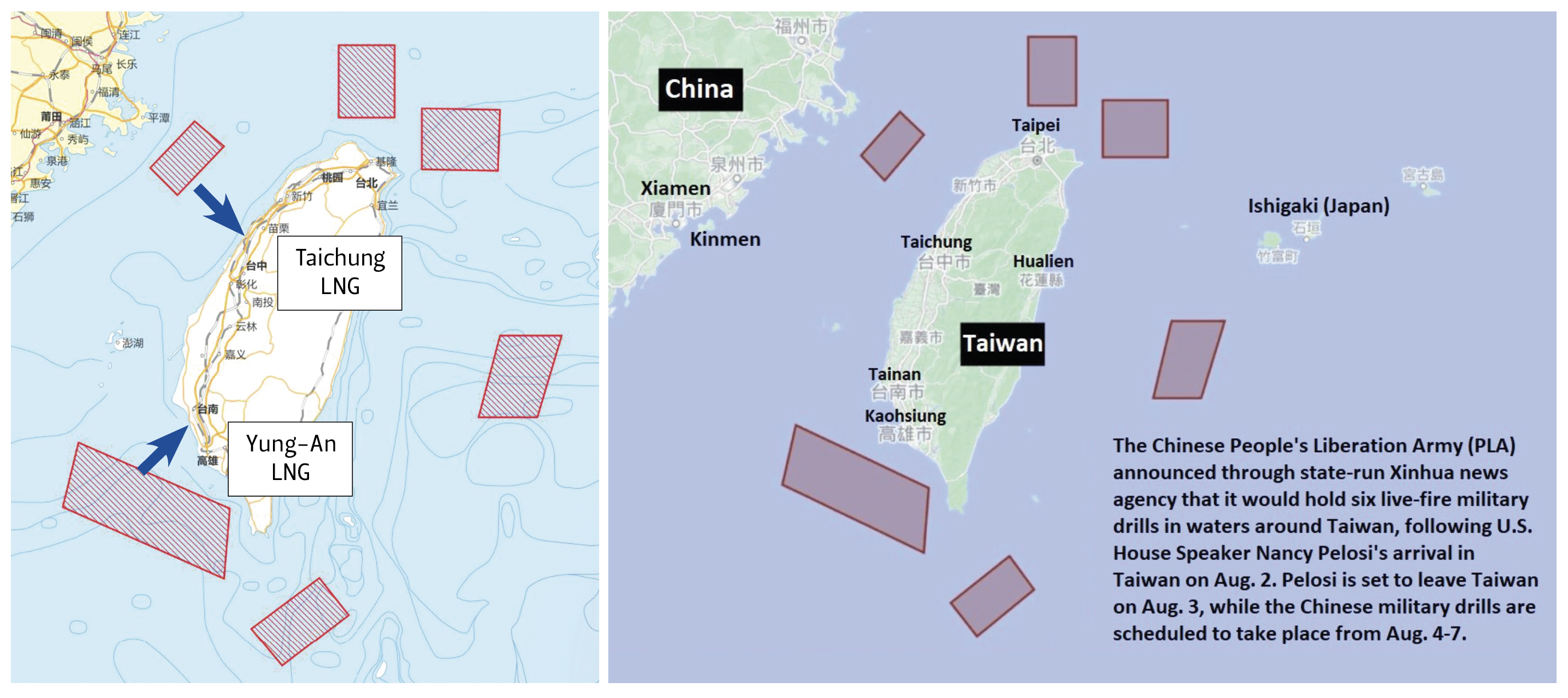
Source Focus Taiwan, August 3, 2022, https://focustaiwan.tw/cross-strait/202208030002.
But the actions are much more significant than they appear. Consistent with the Russia-China “partnership without limits,” China’s action in the Taiwan Strait enhances Russia’s ability to use its LNG supply as an energy weapon in the region. Taiwan announced on February 25, 2022, that it would join the international sanctions against Russia and that it would not renew a five-year LNG sales agreement for deliveries from Sakhalin II when the contract expired in March.[41] Taiwan has replaced those volumes with LNG from several sources, including Cheniere Marketing, with whom they signed a 25-year LNG sales agreement for 2 mtpa on a delivered ex-ship basis.[42] The country is also in the process of expanding the Taichung regasification terminal to 10 mtpa[43] and ordering a new fleet of 16 LNG carriers to meet its growing energy needs.[44] China’s blockade calls into question the energy security that these investments would otherwise provide Taiwan and—regardless of whether it was part of China’s goal this time—helps Russia extend its gas geopolitical game to challenge US allies and trading partners in Asia.
Russia and China working in tandem is likely to become a more systemic feature of the international environment, with the two countries acknowledging cooperation in some instances and possibly denying it in others. Their ability to affect energy markets, particularly as part of a coordinated military or diplomatic strategy, should not be underestimated. The US and its allies will need to address this challenge as soon as this winter and possibly for many winters to come. It’s best to start right away.
Where do the US and its Allies Go From Here?
The Good News: More LNG Capacity, Mostly in the US, is Coming Online
While cold weather, further conflict, or unanticipated outages could each strain the ability of LNG producers and customers to supply allies and trading partners in both the Atlantic and the Pacific, there is good news. First, as noted, PHSMA has reached a preliminary agreement to allow the Freeport LNG terminal to restart all three trains at close to full capacity in early October, bringing some 15.0 mtpa back onto the market. That project was a leading supplier to Europe during the first few months of the invasion this year.
Second, additional supply is scheduled to start production in 2022 and 2023. Cheniere began commercial operations of train 6 at its Sabine Pass terminal in late February 2022, adding some 4.5 mtpa of baseload capacity and 5.76 mtpa of peak capacity. Venture Global’s Calcasieu Pass LNG project commissioned trains 1-12 by May of 2022, and trains 13-18 are anticipated to be commissioned by September of this year. Together, they will add 10.0 mtpa of baseload capacity and 12.0 of peak capacity. Golden Pass is anticipated to commission its first train in 2023, adding 5.2 mtpa of baseload capacity and 6.0 of peak capacity. An additional 22-25 mtpa is under construction at Golden Pass and Venture Global’s Plaquemines facilities. Both are planned to start up in 2024. Together, US LNG export capacity, based upon facilities already under construction, is expected to grow 20% this year (not including another 20% for the restoration of Freeport LNG) and more than 50% over three years.[45]
Current and pending volumes highlight the influence of US firms in LNG markets in the near and medium terms. No other country has added significant LNG liquefaction capacity in 2022 to date. Also, the capacity added by the US and that the US plans to add through 2024 is more than capacity additions in 2022-24 by all other countries combined. The only two non-US operations slated to begin production in 2022 are Indonesia’s Tangguh LNG T3 (3.8 mtpa) and Coral-Sul FLNG (3.4 mtpa) in Mozambique. And in 2023, only one facility, Congo-Brazzaville, is supposed to begin producing LNG (1.4 mtpa). The fate of Russia’s Portovaya Luga (1.5 mtpa), initially slated for a 2022 start, is now uncertain. It has been experiencing difficulties due to sanctions imposed on Russia and likely will need to move its expected commissioning beyond the initial 2022 goal. No new LNG liquefaction addition has been planned outside of the US in 2024. And while many final investment decisions are expected to take place in 2022 and 2023, given the time that is needed to build an LNG export terminal, they will not be able to add to the world’s liquefaction capacity for several years to come. US leadership in new liquefaction capacity addition is probably best illustrated by Figure 6.
Figure 6 — Global Liquefaction Capacity Growth by Region, 1990–2027
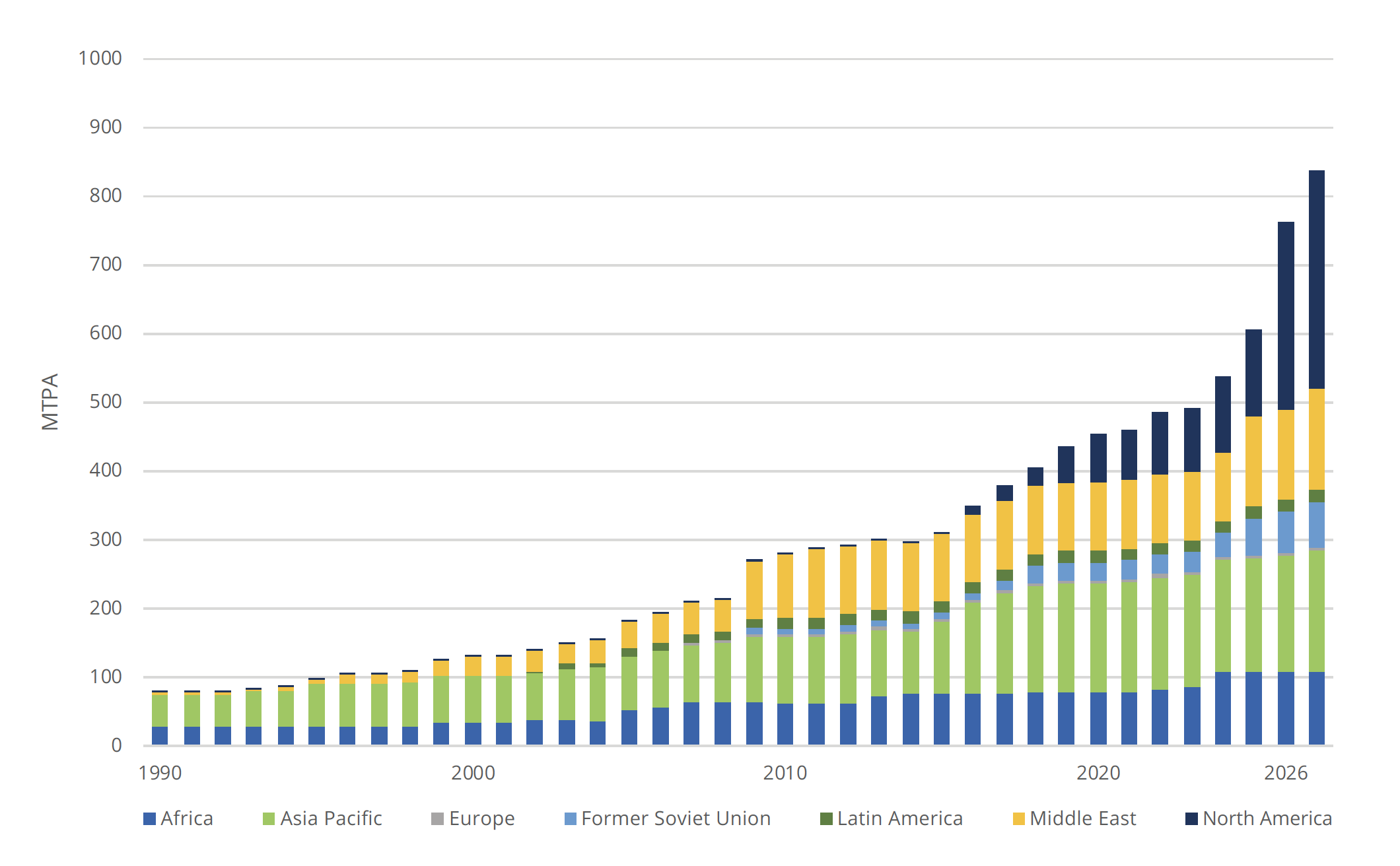
But This and Future Winters Could be Challenging. The US and its Allies Must be Ready to Fight the Gas War on both the European and Asian Fronts
Even with increased supply, relying on last year’s US playbook is not likely to be enough. What our allies and trading partners seek—and what Russia (and perhaps China) seek to eliminate—are not only methane molecules but, even more importantly, the certainty that we will stand by our allies and trading partners even during difficult times. Energy security is a critical part of this certainty, and our adversaries illuminate our vacillations when they occur.
To this end, it is imperative that government officials avoid giving credence to calls for export bans and trade embargoes. Energy supplies are tight and will likely remain so, in part (but not fully) because of the geopolitical tensions created on both the Atlantic and Pacific fronts. Prices will continue to be high, and there will be calls from some quarters—as there have been already from some in the US, Europe, and Australia—to placate domestic audiences by backing away from the commitments and difficult decisions necessary to confront totalitarian adversaries. Only by showing resolve to meet our trading commitments and providing energy to support our allies will the democratic nations of the world see this and other coming winters through as a united group.
Indeed, the Russian invasion of Ukraine highlighted for Europe that energy security is inseparable from national security. Now a second front is opening, highlighting once again that energy security is crucial to national security, as Russia—with help from China—starts to play its gas geopolitical game in Asia.
This is not a time to be timid or uncertain. We must reaffirm our resolve to meet our energy commitments and support our trading partners. We must also demand that our trading partners and allies apply similarly uncompromising logic. Winter will shortly be upon our allies in Europe and north Asia, and storage tanks need to be filled. Our adversaries know this and are counting down the days.
Endnotes
[1] “NATO-Russia: Setting the Record Straight,” NATO, July 26, 2022, https://www.nato.int/cps/en/natohq/115204.htm.
[2] “$1 Billion in Additional Security Assistance for Ukraine,” US Department of Defense, Press Release, August 8, 2022, https://www.defense.gov/News/Releases/Release/Article/3120059/1-billion-in-additional-security-assistance-for-ukraine/.
[3] Bianca Pallaro and Alicia Parlapiano, “Four Ways to Understand the $54 Billion in US Spending on Ukraine,” The New York Times, May 20, 2022, https://www.nytimes.com/interactive/2022/05/20/upshot/ukraine-us-aid-size.html.
[4] “NATO’s military presence in the east of the Alliance,” NATO, July 8, 2022, https://www.nato.int/cps/en/natohq/topics_136388.htm.
[5] “FACT SHEET: United States, G7 and EU Impose Severe and Immediate Costs on Russia,” The White House, April 6, 2022, https://www.whitehouse.gov/briefing-room/statements-releases/2022/04/06/fact-sheet-united-states-g7-and-eu-impose-severe-and-immediate-costs-on-russia/.
[6] Gabriel Collins, Kenneth B. Medlock III, Anna Mikulska, and Steven Miles, Strategic Response Options if Russia Cuts Gas Supplies to Europe, Rice University’s Baker Institute for Public Policy, Houston, Texas, February 2022, https://www.bakerinstitute.org/research/strategic-response-options-if-russia-cuts-gas-supplies-europe/.
[7] Anna Mikulska and Steven Miles, “US LNG ‘GasLift’ Floods European Terminals Ahead Of Russia Gas Cutoff,” Forbes (blog), May 12, 2022, https://www.forbes.com/sites/thebakersinstitute/2022/05/02/us-lng-gaslift-floods-european-terminals-ahead-of-russia-gas-cutoff/?sh=3d44136c6df3.
[8] Steven Miles and Gabriel Collins, A Bridge Over Troubled Water:1 LNG FSRUs Can Enhance European Energy Security, Issue brief no. 03.29.22., Rice University’s Baker Institute for Public Policy, Houston, Texas. https://doi.org/10.25613/XHR8-HB47.
[9] Gabriel Collins, Anna Mikulska, and Steven R. Miles, “Winning the Long War in Ukraine Requires Gas Geoeconomics,” Baker Institute Working Paper, August 4, 2022, https://www.bakerinstitute.org/media/files/files/4c341ce4/wp-ces-ukraine-geoeconomics-080422.pdf.
[10] “Peak” utilization, according to data provided by the US Energy Information Administration, is approximately 120% of “baseload” capacity, which is defined as “the amount of liquefied natural gas produced in a calendar year under normal operating conditions based on engineering design of a facility” (emphasis added). See US Energy Information Administration, Liquefaction Capacity Table.
[11] EIA (US Energy Information Administration, “Daily US liquefied natural gas export capacity (peak) utilization (Jan 2017–Jun 2022),” Today in Energy, July 25, 2022, https://www.eia.gov/todayinenergy/images/2022.07.25/chart2.svg.
[12] “Fire Causes Shutdown of Freeport Liquefied Natural Gas Export Terminal,” US Energy Information Administration, June 23, 2022, https://www.eia.gov/todayinenergy/detail.php?id=52859.
[13] Cedigaz, “Trade – Monthly LNG Flows,” August 2022.
[14] Bruna Alves, “EU: monthly electricity prices by country 2022,” Statista, August 3, 2022, https://www.statista.com/statistics/1267500/eu-monthly-wholesale-electricity-price-country/.
[15] ENTSOG (European Network of Transmission System Operators for Gas), “ENTSOG Transparency Platform,” accessed August 8, 2022, https://transparency.entsog.eu/; “Gazprom, Siemens Spar Over Turbine Maintenance Slowing Gas Flows,” Bloomberg, July 27, 2022, https://www.bloomberg.com/news/articles/2022-07-27/gazprom-warns-turbine-issues-for-nord-stream-are-piling-up.
[16] “Regulation of the European Parliament and of the Council amending Regulations (EU) 2017/1938 and (EC) No 715/2009 with regard to gas storage,” June 24, 2022, https://data.consilium.europa.eu/doc/document/PE-24-2022-INIT/en/pdf.
[17] “Energiesicherungspaket: Weitere Stärkung der Vorsorge,” July 21, 2022, https://www.bmwk.de/Redaktion/DE/Downloads/Energie/20220721_energiesicherungspaket.pdf?__blob=publicationFile&v=8.
[18] German officials have indicated that full gas storage could support about 2-2.5 months of Germany’s natural gas over winter. See “Germany's network agency head says full gas storage enough for 2.5 months,” Reuters, June 23, 2022, https://www.reuters.com/article/ukraine-crisis-germany-gas-storage-idINL1N2YA2SD.
[19] Julian Wettengel, “German gas storage levels could reach 90% despite reduced Nord Stream flows – operators,” Clean Energy Wire, July 28, 2022, https://www.cleanenergywire.org/news/german-gas-storage-levels-could-reach-90-despite-reduced-nord-stream-flows-operators.
[20] “Germany Reaches Gas Storage Milestone Two Weeks Ahead of Plan,” Bloomberg, August 17, 2022, https://www.bloomberg.com/news/articles/2022-08-14/germany-reaches-gas-storage-milestone-two-weeks-ahead-of-plan#xj4y7vzkg.
[21] Aura Sabadus, “EU industrial consumers brace for gas demand reduction plans,” Independent Commodity Intelligence Services, July 20, 2022, https://www.icis.com/explore/resources/news/2022/07/20/10786873/eu-industrial-consumers-brace-for-gas-demand-reduction-plans/.
[22] “European gas: industrial demand destruction,” European Gas Hub, July 2022, https://www.europeangashub.com/european-gas-industrial-demand-destruction.html.
[23] “The % Full has been calculated using the gas in the storage from AGSI+ platform and the Working Gas Volume from GSE Storage MAP database; since the last update was January 2018, updated AGSI values for WGV have been taken into account for those storages with remarkable difference.” ENTSOG, “ENTSOG Yearly Supply Outlook 2022-2023,” July 20, 2022, https://www.entsog.eu/sites/default/files/2022-07/SO0036-22_Yearly_Supply_Outlook_2022-2023_2.pdf.
[24] “Freeport LNG and Pipeline Hazardous Safety Materials Administration Enter into Consent Agreement,” Freeport LNG, August 3, 2022, http://freeportlng.newsrouter.com/news_release.asp?intRelease_ID=9748&intAcc_ID=77.
[25] In January 2022, President Biden invited Emir Tamim bin Hamad al Thani, the ruler of Qatar, to the White House to discuss cooperation in diverting LNG cargoes to Europe, proposing to designate Qatar as a “major non-NATO ally.” See Karen DeYoung and Ashley Parker, “Qatar’s emir visits White House, as Biden may need help with natural gas for Europe,” The Washington Post, January 31, 2022, https://www.washingtonpost.com/national-security/2022/01/31/qatar-ukraine-natural-gas-europe/.
[26] Yuka Obayashi and Marwa Rashad, “Japan to divert LNG to Europe amid Russia-Ukraine tension,” Reuters, February 9, 2022, https://www.reuters.com/business/energy/japan-diverting-lng-europe-some-already-route-industry-minister-2022-02-09/.
[27] Renju Jose and Sonali Paul, “Shell Prelude LNG loading disrupted for at least 2 weeks, worsening global supply,” Reuters, June 28, 2022, https://www.reuters.com/business/energy/shell-says-prelude-lng-shipments-disrupted-until-least-mid-july-2022-06-28/; Angela Macdonald Smith, “Shell Prelude LNG shutdown: Unions extend protected action amid pay dispute,” Australian Financial Review, July 14, 2022, https://www.afr.com/companies/energy/unions-extend-lng-shutdown-over-pay-dispute-20220714-p5b1ia.
[28] Sonali Paul and Renju Jose, “Australia considers curbing gas exports to avert domestic supply crunch,” Reuters, August 1, 2022, https://www.reuters.com/business/energy/australias-east-coast-may-face-gas-shortfall-next-year-watchdog-warns-2022-07-31/.
[29] Gabriel Collins, Steven Miles, and Anna Mikulska, “Winning the Long War in Ukraine Requires Gas Geoeconomics,” Baker Institute Working Paper, August 4, 2022, https://www.bakerinstitute.org/media/files/files/4c341ce4/wp-ces-ukraine-geoeconomics-080422.pdf.
[30] Yuka Obayashi, Emily Chow, and Ron Bousso, “Russia Seizes Control of Sakhalin Gas Project, Raises Stakes with West,” Reuters, July 1, 2022, https://www.reuters.com/business/energy/russia-decree-sakhalin-2-project-knocks-mitsui-mitsubishi-shares-2022-07-01/.
[31] Yuka Obayashi and Joyce Lee, “Japan, South Korea buyers have not yet been asked to pay roubles for Russian LNG imports,” Reuters, July 5, 2022, https://www.reuters.com/business/energy/japan-s-korea-buyers-not-yet-asked-pay-roubles-russian-lng-imports-2022-07-05/.
[32] Vladimir Afanasiev, “Japan’s LNG Contracts to Remain Intact Despite Russia Seizing Control of Sakhalin 2,” Upstream Online, July 4, 2022, https://www.upstreamonline.com/lng/japan-s-lng-contracts-to-remain-intact-despite-russia-seizing-control-of-sakhalin-2/2-1-1252148.
[33] Gabriel Collins, Russia’s Use of the Energy Weapon in Europe, Issue brief no. 07.18.17. Rice University’s Baker Institute for Public Policy, Houston, Texas, July 18, 2017, https://www.bakerinstitute.org/research/russias-use-energy-weapon-europe.
[34] In a political twist, Gas Authority of India, Ltd. (GAIL) announced that Gazprom Marketing and Trading Singapore (GMTS) has reportedly failed to supply some of the LNG cargoes required under their 20-year LNG agreement and has informed GAIL that they may not be able to fulfill the entire agreement going forward. The cargoes were to be supplied from the Yamal LNG plant in Russia. GMTS is owned by Gazprom Germania, which is no longer owned by Gazprom, adding to the political intrigue. In any event, the shortfall of LNG cargoes means that GAIL will need to seek either LNG or a substitute fuel to replace the lost cargoes, further tightening Asian energy markets. See “GAIL Rationing Gas As Russia's Gazprom Unit Cuts Supplies: Report,” Business Standard News, August 2, 2022, https://www.business-standard.com/article/economy-policy/gail-rationing-gas-as-former-gazprom-unit-cuts-supplies-report-122080101027_1.html.
[35] “Japan to ask US, Australia to ensure stable LNG supply,” Reuters, July 12, 2022, https://www.reuters.com/business/energy/japan-ask-us-australia-ensure-stable-lng-supply-industry-minister-2022-07-12/.
[36] EIA, “Monthly US liquefied natural gas exports by destination region (Jan2020–Apr 2022),” Today in Energy, June 7, 2022, https://www.eia.gov/todayinenergy/images/2022.06.07/main.svg.
[37] EIA, “Monthly US liquefied natural gas exports by destination (Jan2020–Apr 2022),” Today in Energy, June 7, 2022, https://www.eia.gov/todayinenergy/images/2022.06.07/chart2.svg.
[38] “China Warns Airlines to Avoid ‘Danger Zones’ Around Taiwan,” Bloomberg, August 2, 2022, https://www.bloomberg.com/news/articles/2022-08-03/china-warns-airlines-to-avoid-areas-near-taiwan-as-tensions-rise.
[39] “Delays of LNG Via Taiwan Strait Only Impact China, Taiwan,” Bloomberg, August 4, 2022, https://blinks.bloomberg.com/news/stories/RG35JBDWRGG3.
[40] Ibid.
[41] “Taiwan set to wind down Russian LNG imports as contract expiry nears,” Hellenic Shipping News, March 14, 2022, https://www.hellenicshippingnews.com/taiwan-set-to-wind-down-russian-lng-imports-as-contract-expiry-nears/.
[42] “Cheniere and CPC Sign 25-Year LNG Sale and Purchase Agreement,” Chenier Energy, Inc., Press Release, August 10, 2018, https://lngir.cheniere.com/news-events/press-releases/detail/176/cheniere-and-cpc-sign-25-year-lng-sale-and-purchase.
[43] Simon Ferrie, “Taiwan breaks ground on LNG terminal expansion,” Petroleum Economist, July 19, 2022, https://pemedianetwork.com/petroleum-economist/articles/gas-lng/2022/taiwan-breaks-ground-on-lng-terminal-expansion/.
[44] “Taiwan plans to build up to 16 LNG carriers,” LNG Prime, January 13, 2022, https://lngprime.com/vessels/taiwan-plans-to-build-up-to-16-lng-carriers/38951/.
[45] US Energy Information Administration, Liquefaction Capacity Table.
[46] International Gas Union, “Figure 4.1 Global liquefaction capacity growth by region, 1990 – 2027,” in World LNG Report 2022, https://www.igu.org/resources/world-lng-report-2022/.
This material may be quoted or reproduced without prior permission, provided appropriate credit is given to the author and Rice University’s Baker Institute for Public Policy. The views expressed herein are those of the individual author(s), and do not necessarily represent the views of Rice University’s Baker Institute for Public Policy.


